.jpg)
(Photograph by Ansel Adams, 1962. Sierra Nevada, Winter Evening.)
Black-and-white photography is still a viable art form today; some argue that black-and-white photography with large-format cameras is unparallelled. Ansel Adams would know, I suppose.
Its very nature suggests it is less about representation and documentation than selection and perception.
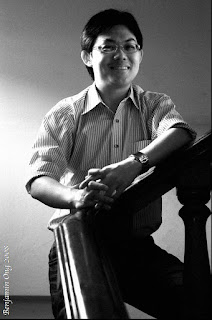
(Emmanuel at the Asia-Europe Institute, University of Malaya.)
Perhaps that is why I have been interpreting a good number of my pictures in black-and-white lately. After all, colours sometimes deceive, and in two ways at that: sometimes the colours of a scene carry it so powerfully that most, if not all, other elements pale in comparison; and sometimes colour photographs bring back to mind the scenes they represent with such familiarity that we enjoy the photographs purely on the strength of nostalgia.
But with black-and-white, an image loses a lot of what makes it present and immediate. What is left is the strength of the composition, the viscerality of the emotion(s) conveyed by the subject(s), and the texture of the scene. It is a residual art form not unlike the art of surveying the ruins of a lost civilisation: ruins which may at times have a deeper and greater story to tell than the glories of the original.
* * * * *
When the opportunity to take photos as part of a team (this is very important; if I were the only photographer, I would've probably shot in colour) for the PKV's Easter Celebration came about, I gave serious consideration to black-and-white. I knew Tim and Yen would be shooting in colour, so I decided to experiment with black-and-white using my Canon EOS300 film SLR.
Perhaps it was a subconscious thing. I'd done the poster in black-and-white (for that was how I saw the theme and overall mood of Entangled) and so it was almost natural to follow with cast and ensemble photos in the same kind of contrasty black-and-white; thus was the treatment given to the photos Tim shot for the programme book. (A side advantage of this was that printing cost less in the absence of colour, and an artistic experiment found expression.)
In addition to the interest in black-and-white, I'd been inspired by the stuff I was reading about in this book on stage documentation and representation by Matthew Reason. The book also gave me ideas in terms of framing and the overall philosophies undergirding stage photography.
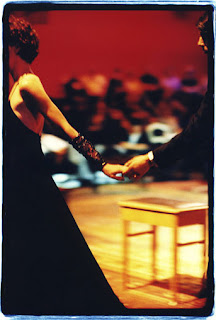
(Photograph by Chris Van der Burght, 1999. From the production India Song.)
Take, for instance, what one of the book's featured photographers said:
"To make it possible for me to work as a theatre photographer, I chose to take the theatrical as reality, a reality without physical borders. This reality doesn't stop at the edge of that stage."
-- Chris Van der Burght, Flemish photographer
I would later tell Suit Lin that my photography was less an effort to document the musical than an artistic venture in which the musical was my subject; I realised after I had said those words that they were true [to borrow a Royal Tenenbaums phrase].

And so I armed myself with three rolls of film (for experimentation): Fujifilm Neopan 400 (which I bought at the KL Photography Fair at Berjaya Times Square last September), Ilford Delta 400 and Kodak CN 400 (both of which I bought from Keat Camera in Pudu for the event).
I knew I had to use the film sparingly and shoot with discretion, but on the big day I wished I had a fourth roll of film. In retrospect, three was ideal; if I had four, I would have wished for a fifth.
Besides, four would've blown the budget. ;-)
* * * * *
I am deeply indebted to the PKV for graciously sponsoring this experiment. I hope the pictures and the overall effort on the part of the photography team are worth it.
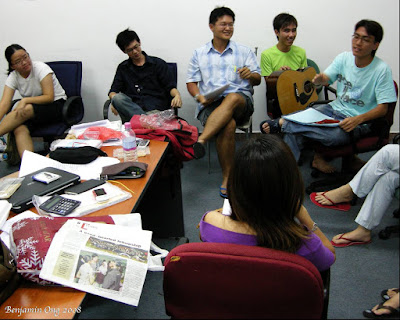
What follows is a selection of some of my best black-and-white shots of the night. My intention was to convey the spirit of the characters more than anything else; perhaps that is why I made a conscious effort to strip the scenes of the colour which would have immediately brought the viewer back to the night of 26 March 2008.
Once again, as with the poster, I am allowing light and shadow to tell the story and narrate the plight of the characters in the play.
When I say these are some of my best, I mean that they are some of my favourite; pictures which, to some extent, break new ground--in varying degrees--for me. I've always judged this aspect of a picture's quality by whether or not I'd enlarge, frame and hang it.
A word on the dimensions:
I have cropped each of the pictures in 'panorama'/widescreen (15x8) and square formats. (Most digital compact cameras use a 4x3 format, and 35mm film and digital SLR sensors are usually 3x2.)
The wide ones are because I wanted to convey the pictures with a touch of cinematic texture, and movies are almost always shot in the elongated format. Unfortunately these images suffer the most because of the screen orientation on this page; do click on the images to get a better view.
The square ones were cropped in an attempt to see what photography with medium-format cameras (for instance, Hasselblad and Mamiya) might be like.
Enjoy, and do give me feedback!
* * * * *
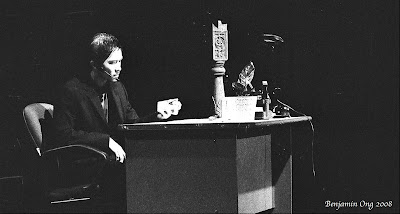
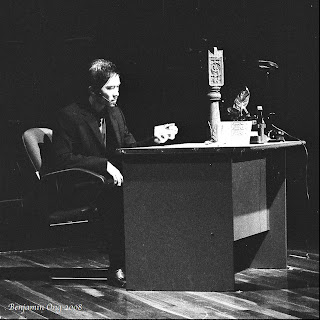
Edmond (Titus) at his desk, listening to a tape recording.
(It was in the photographing of this scene that members of the audience wondered if I were a part of the cast, a prop or something else; I stood centrestage and shot from there. The centre lights were dimmed, of course!)
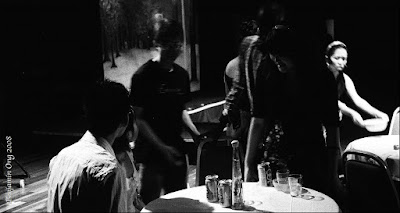
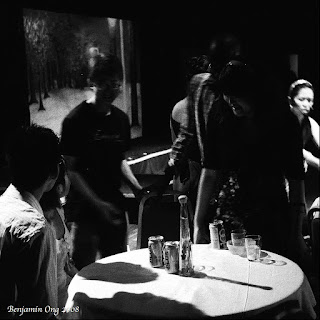
A scene at the café. Jen Hann makes a surprise cameo as a waiter; he had come out to take Bernardo's stack of paper, but was unable to leave the scene before the lights came on.
In the background you can see one of the hot sisters (Jia Hui), serving Anita a bowl of ginger soup.
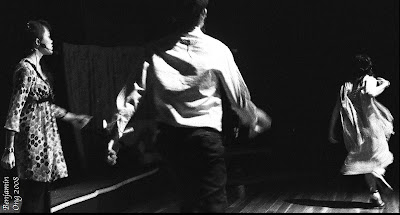
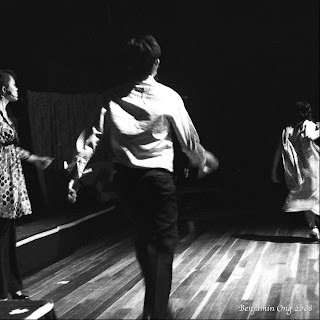
Cassandra (Ai Wei) accuses her siblings Anita (Siew Yong) and Bernardo (Denis) of not loving her.

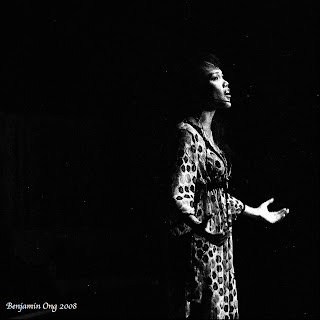
Anita sings 'Can't You See' (to the tune of 'Entangled'). Probably the most harrowing scene of the First Act--perhaps even the whole musical.
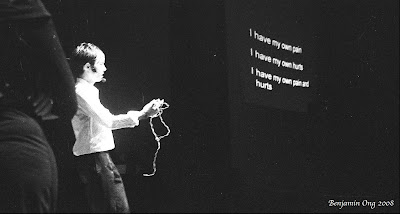
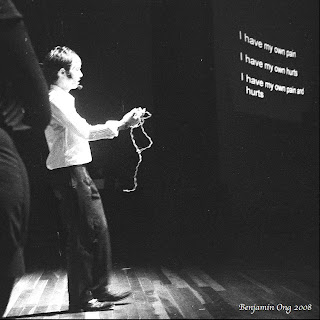
Bernardo lifts his own ropes from his pocket as he sings the final lines of 'Silence' while the Narrator (Shoba, who also plays Desiree) looks on.
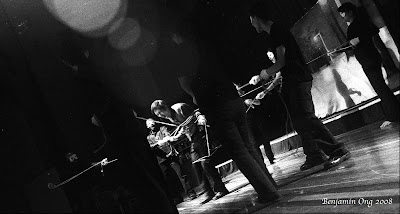
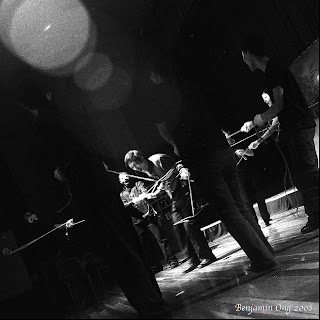
A metaphorical scene in which Edmond struggles with his entanglement. The ensemble, masked and dressed in black, tie him up and laugh mockingly at him.
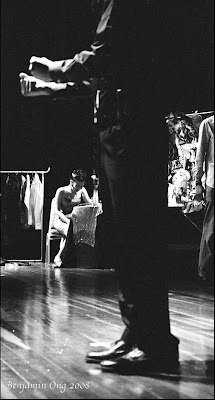
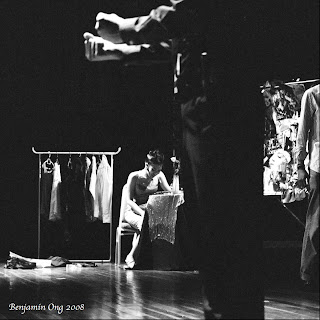
Edmond (not physically present) narrates his letter as Bernardo and Anita read it; in it he proposes to kill Cassandra.
(In this picture I attempted to demonstrate Edmond's control of the events; how Cassandra is literally under his grasp.)
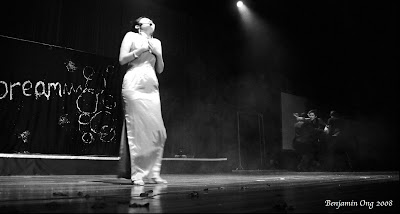
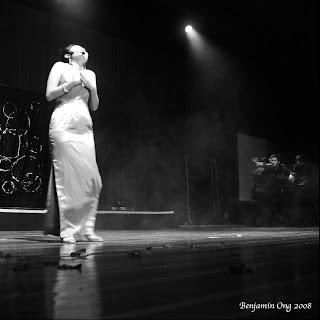
Cassandra sings the climax song, 'Entangled' as Edmond, having regretted his actions, tries to get to her but is tackled repeatedly by the ensemble. Crushed rose petals lie at her feet as memories of her dream for stardom fade away.
(The actual negative contains the entire word 'Dream'; the slight cropping is due to a flaw in the scanning. This picture came out better than I'd expected, with the lighting balance nearly flawless in spite of the relatively uneven stage lighting.)
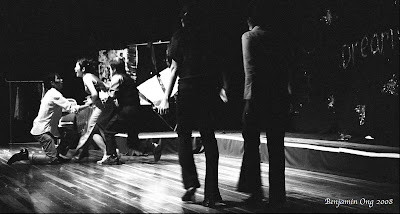
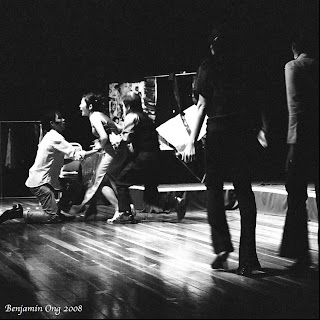
In the tussle between Bernardo and Edmond, Cassandra is accidentally stabbed by her own brother.
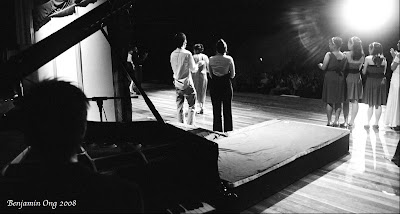
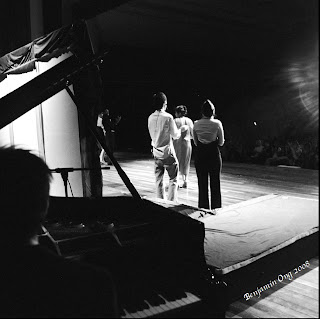
Curtain call!
(The whole idea was to see the curtain call from Jon's point-of-view. The tall-ish backdrop just beyond the piano holds some painful memories for me; I fell from a chair while making my final exposure from over the backdrop.)
* * * * *
This entry took quite a long time (I started in the early afternoon of 16 April). More often than not, I'd run out of stamina; working through the photos was rather tough (as was writing the text) as I had to adjust the contrast to restore quality lost in the scanning of the negatives into digital format.
Some technical trivia: I had each roll of film pushed one stop, i.e. I shot the rated ISO400 at a functional ISO800. Aperture values used were between f/4 and f/5.6 (the widest settings on the 28-90mm lens), and shutter speeds were set manually using information from random digital assays made during the rehearsals.
I covet your comments!
No comments:
Post a Comment